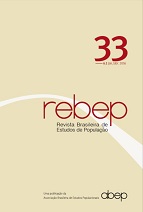Availability of siblings in Brazil: a methodological study on kinship relationships
DOI:
https://doi.org/10.20947/S0102-309820160002Keywords:
Demographic transition, Kinship models, Availability of siblingsAbstract
When fertility declines, it is not only the number of children that becomes smaller, but the number of siblings as well. To determine changes in the number of siblings over time in Brazil, this study uses a method that is designed to estimate, through mathematical models which use only fertility and mortality rates, the availability of surviving siblings in different cohorts. The results indicate that, at the beginning of the demographic transition, the mean number of the born alive siblings is established at high levels and suffers a sharp decline during the transition, mainly due to falling fertility. They also show that the mean number of the surviving siblings at older ages tends to be very similar for older and younger cohorts. However, the mean number
of surviving siblings during the childhood of these cohorts tends to differ greatly. This is due to high mortality, especially infant mortality, on the one hand and, on the other, from fertility decline which reduces the number of live births in more recent cohorts while the reduction of mortality increases their chances of survival. The study’s conclusion points out the following trends: the mean number of surviving siblings will tend to settle at lower levels in coming years and the mean number of surviving siblings tends to be increasingly closer to the mean number
born alive. Despite current low levels of fertility, it would be incorrect to speak of the extinction of siblings and, consequently, of cousins, uncles, etc.
DOI http://dx.doi.org/10.20947/S0102-309820160002
Downloads
Downloads
Published
How to Cite
Issue
Section
License
Papers published in Rebep are original and protected under the Creative Commons attribution-type license (CC-BY). This license allows you to reuse publications in whole or in part for any purpose, free of charge, even for commercial purposes. Any person or institution can copy, distribute or reuse the content, as long as the author and the original source are properly mentioned.

